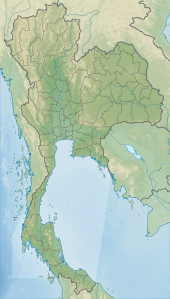Phu Pha Man National Park
| Phu Pha Man National Park | |
|---|---|
| อุทยานแห่งชาติภูผาม่าน | |
 In 2005 | |
| Location | Thailand |
| Nearest city | Khon Kaen |
| Coordinates | 16°44′38″N 102°0′4″E / 16.74389°N 102.00111°E / 16.74389; 102.00111 |
| Area | 350 km2 (140 sq mi) |
| Established | 2000 |
| Visitors | 9,682 (in 2019) |
| Governing body | Department of National Parks, Wildlife and Plant Conservation |
Phu Pha Man National Park (Thai: อุทยานแห่งชาติภูผาม่าน) is a national park in Thailand's Khon Kaen and Loei provinces. This forested park is home to caves, waterfalls and steep cliffs.
Geography
Phu Pha Man National Park is located about 100 kilometres (60 mi) west of the city of Khon Kaen in the Phu Pha Man and Chum Phae districts of Khon Kaen Province and Phu Kradueng District of Loei Province. The park's area is 218,750 rai ~ 350 square kilometres (140 sq mi).[1] Park elevations range from 200 metres (700 ft) to 800 metres (2,620 ft).[2]
Attractions
Klang Khao cave is notable for its large daily exodus of bats at dusk, making a formation about 10 kilometres (6 mi) long. Other park caves feature stalagmite and stalactite formations. The Lai Thaeng cave hosts rock paintings dating back up to 2,000 years.[3]
The park's highest waterfall is Tat Yai waterfall at 80 metres (260 ft) high. Tat Rong waterfall reaches 60–70 metres (200–230 ft) high. The black rock Pha Nok Khao cliff rises above the Phong river.[3]
Flora and fauna
The park's forest types are mostly evergreen and mixed deciduous. Plant life includes rattan, orchid and cogon grass. Park animals include wild boar, barking deer, monitor lizard and pangolin.[2]
Fossils
Fossil tracks of prehistoric animals have been discovered in the park at the Tat Yai waterfall area, which is part of the Huai Hin Lat Formation. They were first discovered in May 2023, and the first tracks discovered belonged to a sauropod.[4] On 10 January 2024, a team of paleontologists from Thailand's Department of Mineral Resources discovered several more prehistoric footprints dating to the late Triassic period around 220–225 million years ago.[5] Several of the footprints belong to dinosaurs, making them the oldest dinosaur tracks discovered in Thailand and Asia.[6] The tracks are in good condition and show the details of the feet of five different species, including dinosaur types such as ornithopods, theropods, sauropods, and archosaurs.[5][6]
See also
References
- ^ "ข้อมูลพื้นที่อุทยานแห่งชาติ ที่ประกาศในราชกิจจานุบกษา 133 แห่ง" [National Park Area Information published in the 133 Government Gazettes]. Department of National Parks, Wildlife and Plant Conservation (in Thai). December 2020. Retrieved 1 November 2022.
- ^ a b "Phu Pha Man National Park". Department of National Parks (Thailand). Archived from the original on 23 December 2015. Retrieved 22 December 2015.
- ^ a b "Phu Pha Man National Park". Tourism Authority of Thailand. Retrieved 6 May 2020.
- ^ Westwood, Nattapong (23 January 2024). "Thailand unearths Asia's oldest dinosaur footprints dating back 225 million years". The Thaiger. Retrieved 25 January 2024.
- ^ a b "Dinosaur track find could be a first for Thailand". Bangkok Post. Retrieved 25 January 2024.
- ^ a b Yasgin, Evrim (15 January 2024). "Dinosaur footprints add to Thailand's rich fossil record". Cosmos. Retrieved 25 January 2024.
